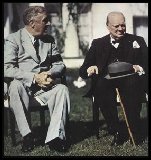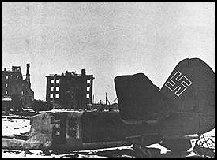 FDR and Churchill at Casablanca |
Project 60: A Day-by-Day Diary of WWII
Remembering the First Fight Against Fascism |
 The Luftwaffe at Stalingrad |
 FDR and Churchill at Casablanca |
Project 60: A Day-by-Day Diary of WWII
Remembering the First Fight Against Fascism |
 The Luftwaffe at Stalingrad |
The British 8th Army reaches Buerat as they chase Rommel across Libya. The Soviets retake Remontnoe, 40 miles
northwest of Elista. The Battle of the Barents Sea begins as
the German heavy cruiser Admiral Hipper and Lutzow, escorted by 6
destroyers, leave their anchorage to attack convoy JW51-B, a 14-ship convoy
escorted by six destroyers, bound for Kola. Attacks at Buna continue as the
Japanese position is split into two sections. The Admiral Hipper and Lutzow
, operating independently, bring convoy JW51-B under fire. The heavily outgunned
British escorts, commanded by Captain
Sherbrooke deploy smoke screens and
the fainted torpedo attacks. The Germans refuse to press the attack and continue
to fire ineffectively at the convoy. In the action, Hipper engages and sinks the
British destroyer Bramble, and one is severely damaged Achates,
which sinks after the battle. The convoy escorts are reinforced by Admiral
Burnett's light cruisers, Jamaica and Sheffield, who damage Admiral
Hipper and sink the German destroyer Friedrich Eckoldt. The still
vastly superior German force withdraws. Soviet pressure far to the north
against Rostov, forces 1st Panzer Army to abandon the Caucasus and begin
withdrawing from the Terek front. Soviet forces enter Velikiye Liki and
heavy street fighting begins as the Germans tenaciously fight for every
building. Elements of the US 1st Corp
attack and dislodge the last Japanese defenders at Buna although fighing
continues around Sanananda. Soviet forces from the 44th and 58th Armies capture Malgobek in the Caucasus as Army Group A begins a general withdrawal from the region. Soviet
forces capture Mozdok and Nalchik in the Caucasus and Chernyshkovskii on the
Chir River. US
Naval forces use proximity air burst fuses for the first time in the war. These
were the first rounds to sense when they were close to the target (something
solid like the ground or an airplane) and detonate before striking the target
increasing their leathal effect several fold. Japanese forces begin to withdraw from Guadalcanal. Soviet
forces continue their advance in the south taking Prokhlandny, Morozovsk and
Tsimlyansk. Admiral Raeder is sacked as commander of the German Navy as Hitler threatens to scrap the surface fleet because of their recent inept performance against convoy JW-51B. The first of 15 trains for the month arrived at Auschwitz from Belgium. Despite the reverses on all battle fronts, the Germans were able to continue and increase the pace of genocide. Of the 24,000 people delivered to Auschwitz in January 1943, 20,000 were gassed upon arrival. US
forces launch new attacks against Mount Austen. General
Rokossovsky, commander of the Don Front, offered General von Paulus surrender
terms at Stalingrad. The terms guaranteed
"their lives and safety and after the end of the war their return to
Germany". He also promises that "...medical aid will be given to all
wounded, sick and frost-bitten...". Paulus, influenced by his chief of
staff, a die-hard Nazi named Schmidt, rejected the offer, condemning 250,000 men
to their death. Fighting around Buna and Sananada continues as the Australian 17th Brigade is airlifted to Wau, establishing a forward base for continued offensive operations in New Guinea. US forces on Guadalcanal hit the Gifu
strongpoint with heavy air and artillery support and continued ground attacks by
the 35th Infantry Regiment. The assault started with an hour-long bombardment from thousands of guns and rocket launchers. Infantry from the 65th and 22nd Armies made good progress in the west, advancing 5 miles. Some progress was made in the north and south, but determined German resistance, limited gains. January 11, 1943 Soviet forces launch attacks south of
Lake Lagoda, succeeding in driving a very thin land corridor to the city.
Supplies are rushed into the city while wounded and non-combatants are shipped
out. All of this was done under constant artillery fire against the cordon. January 12, 1943 The Voronezh and Bryansk Fronts open a
fresh set of offensives against the Hungarian 2nd and German 2nd
Armies. The Hungarian forces are overrun quickly and Soviet spearheads head for
Kharkov. In heavy fighting, the Don Front
overruns the western portion of the Stalingrad pocket. Since the start of
Operation Ring, the front has lost 26,000 men and 125 tanks. German losses have
been as heavy. January 13, 1943 The first of seven airfields in the Stalingrad pocket is captured. January 14, 1943 The Casablanca Conference between Roosevelt and Churchill begins as the western Allies plan the coming offensives throughout the world. To the disappointment of both leaders, the planned invasion of Sicily and the cross-channel attack into France were both postponed, the later until 1944. The leaders also agreed to increase the terror bombing of German cities by RAF Bomber command and to begin daylight "precision bombing" of German industrial targets by US bomber forces. January 15, 1943 German, Italian and Croat forces under
General Alexander von Lohr, launch 'Operation White', the largest campaign
to date against Tito's partisans in Yugoslavia. The Red Army, after two weeks of
desperate street fighting, captures Velikiye Luki in the Valday Hills northwest
of Moscow. January 16, 1943 The main German airfield at Pitomnik is
captured by the Soviets. The Germans in the Stalingrad pocket how had only one
airfield, Gumrak, operationg. Night landings were no longer possible and
supplies had go be parachuted in. The daily deliveries were down to 60 tons, 20%
of the 6th Army's minimal needs. RAF Bomber Command, after four months
of terrorizing other cities, returned to Berlin with a heavy raid of 201
bombers. The attack did little damage (being beyond the range of radar
navigation aides), however, one load of incendiary bombs hit the Deutchlandhalle,
Moments before the bombs landed, the 10,000 people enjoying the circus and all
of the animals had completed the evacuation. The empty hall was quickly consumed
by fire. General Rokossovsky suspends his offensive against the Stalingrad pocket temporarily to regroup. Outside the pocket Millerovo and Zimoviki are captured. January 18, 1943 Soviets announce that the siege of
Lenningrad has been raised. Despite this, rations in the city are still very
limited and German artillery can still reach any part of the city. Attempts to
widen the corridor (only 6 miles wide) fail, at a heavy cost in men and
material. In the Caucasus, Cherkessk, 250 miles southeast of Rostov, is captured by the Red Army The Germans counter attack in Tunisia. Free French defenders give ground but the attack is thrown back by British reinforcements. Australian troops capture Cape Killerton and Wye Point in Papua, New Guinea.British and American tankers at Bou
Arada, Tunisia are confronted for the first time by the vaunted "Tiger"
tank. The heavily armored tank is equipped with the feared 88mm gun and has no
equal in the Allied armory. 1941 Archive: 1942 Archive: Special Editions: Editor's Corner Archive: Hitler's Angle "The story of Prescott Bush and his association with the Nazis begins just before the end of World War I..." The Past Through Tomorrow "It is quite frightening to realize just how similar our nation's actions have been and appear to be heading when compared this way..." Afghanistan and Vietnam: When the "war against terrorism" began, many knowledgeable people warned that our operations in Afghanistan would turn into another Vietnam. Want to Win - Think Before You Lash Out - "If we are serious about taking the war to the enemy, it is time to look ..." The First Fight Against Fascism - We must remember the Spanish Civil War also. Arguing Victory - "... Each nation who fought against fascist tyranny in WWII brought with it part of whole needed to defeat that evil..." War, Glory, Honor and Remembrance - "War is a brutal and savage insult on human society..." The First
Casualty... in time of war, those in power are even more inclined to
hide the truth, since that truth is often manifest in the most gruesome and
terrible acts. Those wishing to contribute items. stories or comments should contact D.A. Friedrichs |